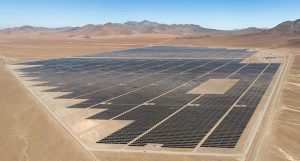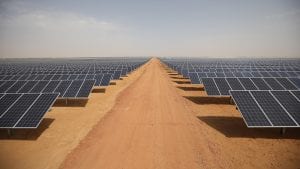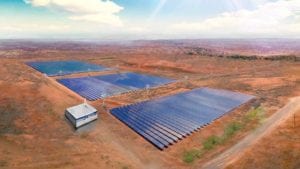 Last year, “utility death spiral” was on our list of the top buzzphrases. A few months later, the Oxford English Dictionary included “death spiral” in its list of new words for 2014.
Last year, “utility death spiral” was on our list of the top buzzphrases. A few months later, the Oxford English Dictionary included “death spiral” in its list of new words for 2014.
Coincidence?
GTM employees regularly use “honky-tonker,” “sword and sorcery” and “wackadoodle” — all added to the dictionary in 2014 — in our conversations around the office. So we’ll take that to mean that our colloquialisms have influence on the Oxford editors.
If there’s any word with the same potential to make the dictionary in 2015, we’ll vote for “YieldCo.” But there are plenty of others with equal weight. Below are ten words, acronyms or phrases that were used a lot within the clean energy industry this year.
1. YieldCos
This year saw a surge in public companies called YieldCos, which pool renewable energy projects and use revenues from power purchase agreements to pay investors. YieldCos, short for “yield company,” are designed to give developers access to new equity investors and cheaper capital to support new projects.
Following the launch of YieldCos from NRG and Pattern Energy in 2013, Abengoa, SunEdison and NextEra were the latest to form their own public entities this year.
Deutsche Bank analysts called YieldCos “the most significant positive catalyst for the solar sector” and predicted that half a dozen more would be formed in the next twelve to eighteen months.
2. Grid defection
Grid defection has never been a real worry for utilities. But a February report from the Rocky Mountain Institute analyzing the economics of grid defection showed that, in theory, millions of consumers around the country could soon disconnect from their utility using commercially available distributed resources.
Although mass grid defection is highly unlikely, the analysis sparked numerous follow-up analyses from large Wall Street banks worried about the future health of investor-owned utilities.
“Decreased reliability from an aging distribution infrastructure, a broadening desire to reduce the carbon footprint, and perhaps most importantly, the reduction of solar panel and battery costs could also work together to make grid independence a reality for many customers one day,” wrote analysts at Goldman Sachs.
3. Solar-plus-storage
Solar-plus-storage is supposedly going to be the catalyst for grid defection. This year, executives at SunPower and SolarCity both said they think battery storage systems will be installed with nearly every solar system within a decade. Some are now asking: is storage the new solar?
At this point, solar-plus-storage is more of a buzzphrase than a legitimate business model. The applications are limited, and the economics are still questionable in most markets. But many in the solar industry believe a tipping point is near — and this year was all about speculating when exactly things would tip.
4. Giga factory
Elon Musk’s most ambitious project may not be launching rockets into space, but building the world’s biggest battery factory. This year, Tesla started working on its Giga factory, a facility outside Reno, Nevada that will eventually be able to pump out 50 gigawatt-hours of battery packs by the end of the decade. Roughly two-thirds of those batteries will be used for electric cars, and one-third will be used for stationary applications.
Elon’s cousin, SolarCity CEO Lyndon Rive, also announced plans for an ambitious gigawatt facility — a 1-gigawatt solar manufacturing plant in Buffalo, New York using technology from Silevo.
Musk and Rive say these facilities are just the start of a period of rapid scaling in battery and solar manufacturing. “This will be followed in subsequent years by one or more significantly larger plants with an order of magnitude greater annual production capacity,” they said in June.
5. REV (Reforming the Energy Vision)
Disruption-themed words and phrases dominated in 2014. But so did words related to managing that disruption. One of the most prominent was REV, short for “Reforming the Energy Vision.”
In April, New York regulators launched their ambitious plan for reforming distribution utilities, which they called REV. The idea is to create an entirely new set of rate structures that will encourage utilities to procure more resources from individual customers and third-party companies providing solar, storage, combined heat and power, microgrids and energy efficiency services.
“I don’t want to create mediocre wires companies. I want to create excellent, innovative companies that have third parties wanting to come to New York and build businesses around DER [distributed energy resources] because they see it’s a marketplace where they can be successful,” said Audrey Zibelman, chair of the New York Public Service Commission.
6. Utility 2.0
REV is an example of the broader shift in the power sector that many people call “utility 2.0,” which also emerged as an oft-used phrase in 2014. The phrase is a more positive iteration of “death spiral.”
This year, two of Germany’s largest utilities, E.ON and RWE, announced plansto focus exclusively on integrating distributed generation and customizing offerings. American utilities are much further behind, but numerous states including California, Hawaii, Massachusetts, Minnesota and New York are all developing regulatory tracks to help utilities manage the transition to a more distributed grid.
“We all came to the conclusion that if we were going to get further, faster, the regulatory framework would need to evolve,” said Rolf Nordstrom, the executive director of the Great Plains Institute, in an interview about Minnesota’s early evolution.
7. Customer empowerment
Electricity consumers are increasingly being referred to as “customers,” not just as “ratepayers.” This is representative of the brewing competition in the power sector, where third-party service providers are starting to loosen the sticky relationship that utilities once had with their customers.
This year saw more utilities frame their efficiency and distributed generation investments around customer empowerment.
“We expect to be soon to market with a robust platform offering rooftop solar to homes and businesses and other forms of sustainable and clean generation that will offer our customers the ability to dramatically reduce their dependence on system power from the centralized grid,” wrote NRG CEO David Crane in a letter to investors earlier this year.
8. Distributed intelligence
As more utilities work to build software-centric intelligence on the grid, the term “distributed intelligence” is commonly being used. It refers to the distribution management software that ties together SCADA, advanced meters, customer care operations and distributed generation assets on the grid into one holistic system.
Today, much of that integration is coming in an unsystematic way. The platforms developed by leading vendors are expensive and are often limited to very large utilities. But as more utilities seek to manage an increasingly complicated grid, the concept of distributed intelligence is certain to guide their investment decisions.
9. Dirt-cheap solar
This year was a breakout one for utility-scale solar in America. Throughout 2014, utilities consistently signed contracts for large-scale solar plants in the 4.5- to 7.5-cent-per-kilowatt-hour range — spawning the phrase “dirt-cheap solar” within the industry.
The price drop for utility-scale solar enabled developers to compete directly with natural gas in Colorado, Georgia, Utah and Texas outside of renewable energy mandates. Between now and the end of 2016, nearly 13,000 megawatts of utility-scale solar projects are expected to be completed.
10. Solar freakin’ roadways
After going dormant for a few years during testing, Solar Roadways came back in 2014 in a big way. In May, the controversial startup released a YouTube videoto supplement its crowdfunding campaign, bringing in more 18.5 million views and sparking national media attention.
The viral video turned the solar freakin’ roadways brand into a brief mainstream phenomenon, even if the technology itself was far from reality. It also caused us to ask once again: could the concept really work?
Source: Greentech Media. Reproduced with permission.










